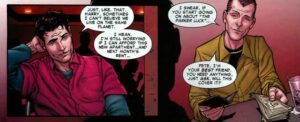
Welcome to Super Hero Collectors, your ultimate destination for in-depth analyses and explorations of the Marvel universe’s most fascinating characters. If this is your first time here, I hope you bookmark this site and come back regularly for fresh superhero content. To all that come here often, I say a hearty “Thank you!” Your visits and comments are always appreciated.
In my last post, we discussed the friendship of Peter Parker (aka Spider-Man) and Harry Osborn. If you have not read that post, I encourage you to take a look at it here. Often in Marvel Comics, tales of heroism, friendship, and rivalry unfold against a backdrop of epic struggles. In the heart of this rich tapestry, the relationships between characters often drive the most compelling stories, and none more so than that of Peter Parker and Harry Osborn. These figures have become cultural icons, transcending the pages of comics to leave an indelible mark on popular media.
Today, we are going to take a closer look at these two young men, who were brought together through their differences. We are going to examine their backgrounds, personality traits and character development, relationships and rivalries, powers and abilities, and finally, their moral compasses and motivations. We will conclude with a look at their impact on the Marvel Universe. I hope you will enjoy this journey as we explore the dynamics between Peter Parker and Harry Osborn.
Peter Parker, who we are aware became known to the world as Spider-Man, and Harry Osborn, infamously recognized as the Green Goblin, are prime examples of how complex character dynamics can redefine storytelling within the superhero genre. What begins as a bond of friendship between two contrasting backgrounds evolves into a nuanced tale of conflicts and redemption, illustrating the intricate nature of human relationships.
Before we explore their unique connection further, it’s important to grasp who Peter Parker and Harry Osborn are, both individually and in relation to each other. This introduction will not only highlight their importance in Marvel’s storied history but also set the stage for a deeper look at their origins and backgrounds, crucial elements that will consolidate our understanding of their eventual destinies.
Origins and Backgrounds
From Queens to Superheroes: Peter Parker
 Peter Parker’s journey from an unassuming high school student in Queens to the legendary Spider-Man is a cornerstone of Marvel’s storytelling. Created by writer Stan Lee and artist Steve Ditko, Peter Parker first appeared in Amazing Fantasy #15 (August 1962). Peter was an average teenager—bright, introverted, and passionate about science. His life took a dramatic turn when he was bitten by a radioactive spider during a school trip. This event endowed him with extraordinary abilities: enhanced strength, agility, the ability to cling to surfaces, and a unique “spider-sense” that alerts him to danger.
Peter Parker’s journey from an unassuming high school student in Queens to the legendary Spider-Man is a cornerstone of Marvel’s storytelling. Created by writer Stan Lee and artist Steve Ditko, Peter Parker first appeared in Amazing Fantasy #15 (August 1962). Peter was an average teenager—bright, introverted, and passionate about science. His life took a dramatic turn when he was bitten by a radioactive spider during a school trip. This event endowed him with extraordinary abilities: enhanced strength, agility, the ability to cling to surfaces, and a unique “spider-sense” that alerts him to danger.
Tragedy struck soon after Peter gained his powers. His beloved Uncle Ben was murdered by a thief Peter had previously ignored, teaching him a harsh lesson: “With great power comes great responsibility.” This mantra became the foundation of Spider-Man’s ethos, driving Peter to use his abilities to protect New York City and its inhabitants.
Legacy of Wealth and Darkness: Harry Osborn
In stark contrast to Peter’s humble beginnings, Harry Osborn was born into wealth and privilege as the son of Norman Osborn, the CEO of Oscorp. Harry Osborn, created by Stan Lee and Steve Ditko, first appeared in The Amazing Spider-Man #31 (1965), when he met Peter at Empire State University. Despite his affluent upbringing, Harry’s life was far from easy. He struggled with his father’s high expectations and emotional distance. Norman’s obsession with success and power left Harry feeling neglected and eager for approval.
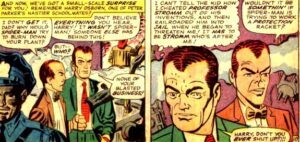
Harry’s path took a dark turn. His struggle with drug abuse first became apparent in The Amazing Spider-Man #96 (1971), written by Stan Lee and drawn by Gil Kane, where Harry’s use of drugs escalated amidst his personal conflicts, particularly with Mary Jane Watson. This period of turmoil was exacerbated when he witnessed his father’s death, presumably at the hands of Spider-Man, in The Amazing Spider-Man #122 (1973). This devastating event, combined with the weight of his father’s legacy, drove Harry deeper into addiction and mental instability. Eventually, the mounting pressure led him to assume the mantle of the Green Goblin in The Amazing Spider-Man #136 (1974), becoming one of Spider-Man’s most personal and tragic adversaries.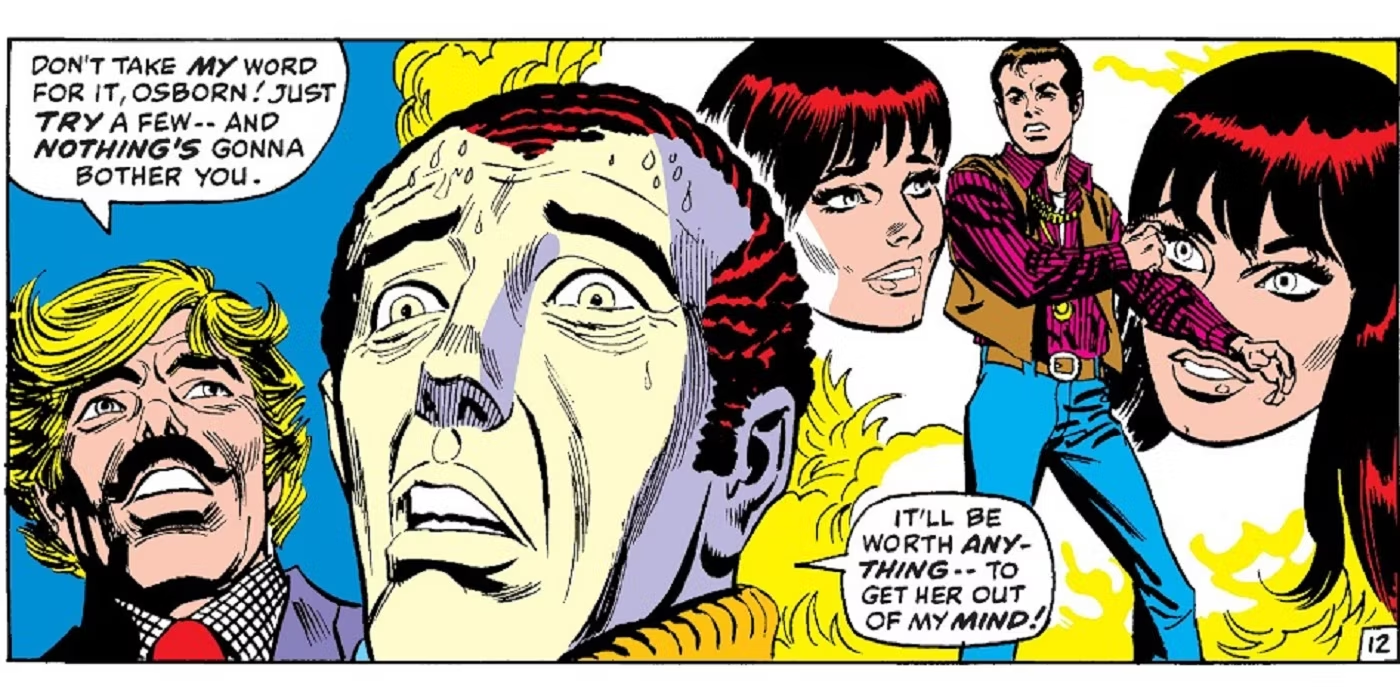 Personality Traits and Character Development
Personality Traits and Character Development
The Hero’s Journey: Peter Parker’s Evolution
Peter Parker’s evolution from a shy teenager to a seasoned superhero is marked by significant personal growth and resilience. Peter’s inherent sense of responsibility and morality sets him apart. He consistently puts others’ needs above his own, even at great personal cost. Balancing his life as a student and nephew, a freelance photographer, and Spider-Man is a constant struggle, but Peter’s determination never wavers.
Key story arcs, such as the death of Gwen Stacy in The Amazing Spider-Man #121-122 (1973) by Gerry Conway and Gil Kane, and the Venom saga starting in The Amazing Spider-Man #300 (1988) by David Michelinie and Todd McFarlane, highlight Peter’s growth. Gwen’s death, a result of his battle with the Green Goblin, profoundly impacted Peter, reinforcing the importance of his responsibilities as Spider-Man. The Venom saga introduced the alien symbiote that initially enhanced his powers but ultimately threatened his moral compass, teaching Peter the value of integrity and inner strength.
The Fall and Rise: Harry Osborn’s Transformation
Harry Osborn’s character arc is a tumultuous journey of internal conflict and transformation. Harry’s desperate desire for his father’s approval and the immense pressure of living up to the Osborn legacy drove him to dark places. His struggles with addiction and mental health are poignant elements of his story, reflecting the human vulnerabilities behind his villainous facade.
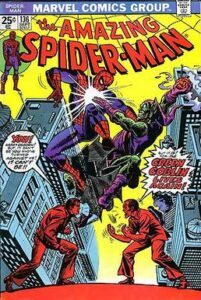 Notable storylines, such as Harry’s initial transformation into the Green Goblin in The Amazing Spider-Man #136 (1974) and his eventual redemption in Spectacular Spider-Man #200 (1993) by J.M. DeMatteis and Sal Buscema, showcase his complex character. Harry’s tenure as the Green Goblin was marked by a fierce rivalry with Spider-Man, fueled by a mix of jealousy, anger, and unresolved grief over his father’s death. His journey was marked not by the heroism that characterized Peter’s transformation, but by the tragedy of succumbing to his darkest impulses. Despite this dark path, moments of redemption and heroism demonstrate Harry’s inherent potential for good, adding depth to his character.
Notable storylines, such as Harry’s initial transformation into the Green Goblin in The Amazing Spider-Man #136 (1974) and his eventual redemption in Spectacular Spider-Man #200 (1993) by J.M. DeMatteis and Sal Buscema, showcase his complex character. Harry’s tenure as the Green Goblin was marked by a fierce rivalry with Spider-Man, fueled by a mix of jealousy, anger, and unresolved grief over his father’s death. His journey was marked not by the heroism that characterized Peter’s transformation, but by the tragedy of succumbing to his darkest impulses. Despite this dark path, moments of redemption and heroism demonstrate Harry’s inherent potential for good, adding depth to his character.
Though their paths are divergent, the lives of Peter Parker and Harry Osborn are threaded together by a shared past and the result of their choices. These beginnings set the stage for the complex individuals they would become, laying the foundation for a friendship tested by time and destiny.
Relationships and Rivalries
Best Friends and Bitter Enemies: A Complex Relationship
The relationship between Peter Parker and Harry Osborn is one of the most intricate dynamics in Marvel comics. Initially, they were best friends, with Peter often seeking solace from the troubles of his double life in Harry’s companionship. However, the revelation of their respective alter egos—Spider-Man and the Green Goblin—introduced a layer of tension and conflict.
Key events strained their friendship, such as Harry’s discovery of Peter’s identity as Spider-Man in The Amazing Spider-Man #135 (1974) and his subsequent assumption of the Green Goblin mantle. Their relationship oscillated between camaraderie and enmity, with their personal bond continually tested by their superhero and villain roles. Despite the betrayals and battles, moments of reconciliation and understanding occasionally emerged, underscoring the complexity of their bond.
Powers and Abilities
Web-Slinging and Spider-Sense: Peter’s Arsenal
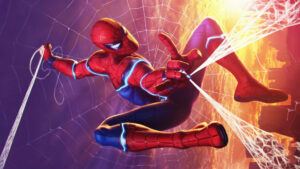
Spider-Man’s powers are a blend of physical prowess and technological ingenuity. His enhanced strength and agility, coupled with his ability to stick to surfaces, enable him to perform incredible feats, from scaling skyscrapers to engaging in acrobatic combat. The “spider-sense” is one of his most distinctive abilities, providing a preternatural awareness of impending danger.
Peter’s scientific genius also plays a crucial role in his superhero persona. He designed and built his web-shooters, which allow him to swing between buildings and ensnare enemies with webbing. His Spider-Tracers give him the ability to track anyone and find them quickly, no matter where they are. This combination of natural abilities and technological innovation makes Spider-Man a formidable and versatile hero. These innovations show us that being a hero isn’t just about muscle; it’s about brains, too.
Goblin Gear and Gadgets: Harry’s Arsenal
On the flip side, Harry Osborn’s gear as the Green Goblin is nothing short of daunting. His arsenal includes Pumpkin Bombs, razor bats, and even a Goblin Glider. These aren’t just cool toys; they’re a testament to the dual nature of technology, serving as tools for both protection and destruction.
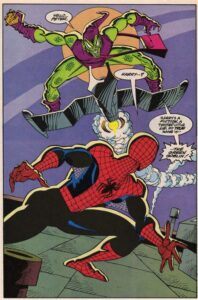 These technologies provide Harry with an imposing arsenal, but they also represent the darkness he grapples with. His struggle is not merely physical but deeply moral. Each tool and weapon he chooses reflects that ongoing internal battle.
These technologies provide Harry with an imposing arsenal, but they also represent the darkness he grapples with. His struggle is not merely physical but deeply moral. Each tool and weapon he chooses reflects that ongoing internal battle.
I really hope that you see the contrast between Spider-Man and Green Goblin is more than just their physical battles; it’s an embodiment of their ethical choices. Peter uses his abilities and intellect to protect, whereas Harry, at various points, is driven to use his resources for revenge or control. This tension is part of what makes their showdowns so captivating. So let’s take a look at what drives their choices.
Moral Compasses and Motivations
The Hero’s Creed: Peter’s Moral Foundation
Peter Parker’s moral foundation is rooted in the principles instilled in him by Uncle Ben. The idea that “With great power comes great responsibility” drives every decision Peter makes as Spider-Man. His unwavering commitment to protecting the innocent and upholding justice defines his actions, even when faced with personal loss and hardship.
Peter’s morals influence his relationships and choices, often putting him at odds with those who prioritize personal gain or vengeance. His altruism and empathy make him a beacon of hope and integrity in the Marvel universe, inspiring other heroes and earning the respect of his allies and adversaries alike.
Torn Between Light and Darkness: Harry’s Struggle
Harry Osborn’s moral journey is marked by a constant struggle between light and darkness. His desire for his father’s approval and the pressures of the Osborn legacy often push him toward malevolent actions. However, moments of clarity and redemption reveal his potential for good, highlighting the duality of his character.
Instances where Harry’s morality was tested include his battles with addiction, his role as the Green Goblin, and his eventual redemption arcs. These moments underscore the complexity of his motivations, driven by a blend of personal pain, familial loyalty, and a longing for redemption. Harry’s character serves as a poignant exploration of the human capacity for both good and evil.
Impact on the Marvel Universe
The Friendly Neighborhood Hero: Peter’s Legacy
Spider-Man’s impact on the Marvel universe is profound and far-reaching. As one of the most popular and enduring superheroes, Peter Parker’s legacy extends beyond his individual exploits. His presence has influenced numerous other heroes and storylines, making him a central figure in Marvel’s tapestry.
Key Issues Highlighting Spider-Man’s Influence
- Secret Wars #1-12 (1984-1985) by Jim Shooter and Mike Zeck: Spider-Man’s role in this epic crossover showcased his abilities alongside other Marvel heroes, emphasizing his importance in the broader Marvel universe.
- The Amazing Spider-Man Annual #3 (1966) by Stan Lee and John Romita Sr.: Spider-Man teams up with the Avengers, demonstrating his capability to hold his own with Marvel’s premier superhero team.
- Marvel Team-Up #1 (1972) by Roy Thomas and Ross Andru: This series often featured Spider-Man partnering with various Marvel heroes, highlighting his versatility and cooperative spirit.
- The Amazing Spider-Man #648-654 (2010-2011) by Dan Slott and Humberto Ramos: Spider-Man’s interactions with the Fantastic Four and the Avengers during the “Big Time” storyline reflect his integration into major Marvel events and teams.
Peter’s ability to inspire and mentor younger heroes is a significant aspect of his legacy. One of the most notable examples is his influence on Miles Morales. Introduced in Ultimate Fallout #4 (2011) by Brian Michael Bendis and Mark Bagley, Miles takes up the Spider-Man mantle in the Ultimate Universe following Peter’s apparent death. Peter’s example of bravery, responsibility, and dedication deeply impacts Miles, shaping his approach to heroism.
Peter’s guidance continues even after his return, mentoring Miles and offering support and wisdom as the younger hero navigates his own journey. This mentorship is vividly depicted in the Spider-Men mini-series (2012) by Brian Michael Bendis and Sara Pichelli, where the two Spider-Men team up and learn from each other. Peter’s influence on Miles extends beyond mentorship; it cements the idea that anyone, regardless of their background, can become a hero. This relationship highlights Peter’s enduring impact on future generations, reinforcing his role as a cornerstone of the Marvel universe.
The Complicated Legacy of the Osborns
The Osborn legacy, marked by power, corruption, and occasional redemption, has a lasting impact on the Marvel universe. Both Norman and Harry Osborn have been significant antagonists, their actions reverberating through countless storylines and affecting numerous characters. Their influence extends beyond their personal vendettas, leaving a complex and multifaceted legacy that continues to shape the Marvel narrative.
Characters Affected by the Osborns
-
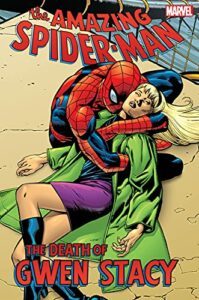
Version 1.0.0 Spider-Man (Peter Parker):
- “The Night Gwen Stacy Died” (The Amazing Spider-Man #121-122, 1973) by Gerry Conway and Gil Kane: Norman Osborn’s actions as the Green Goblin led to the death of Gwen Stacy, a pivotal moment that deeply impacted Peter Parker and his outlook on being Spider-Man.
- Mary Jane Watson:
- The Amazing Spider-Man #96-98 (1971) by Stan Lee and Gil Kane: Mary Jane witnessed Harry’s descent into drug addiction, a subplot that explored the darker sides of the Osborn legacy and its effects on those close to Harry.
- Gwen Stacy:
- The Amazing Spider-Man #121-122 (1973) by Gerry Conway and Gil Kane: Gwen Stacy’s tragic death at the hands of Norman Osborn’s Green Goblin had a lasting impact on the Marvel universe, highlighting the personal stakes and deep emotional scars left by the Osborn family.
- Norman Osborn (himself):
- Dark Reign storyline (2008-2009) by Brian Michael Bendis and various artists: After the events of “Secret Invasion,” Norman Osborn takes control of S.H.I.E.L.D., renaming it H.A.M.M.E.R., and becomes the head of the “Dark Avengers,” showcasing his ability to manipulate power on a global scale.
- Flash Thompson (Agent Venom):
- The Amazing Spider-Man #574 (2008) by Marc Guggenheim and Barry Kitson: Flash Thompson’s military career and subsequent role as Agent Venom were influenced by his interactions with the Osborn family, particularly during Norman’s tenure as a government official.
- The Avengers:
- Siege (2010) by Brian Michael Bendis and Olivier Coipel: Norman Osborn’s assault on Asgard during the “Siege” event highlighted his willingness to go to extreme lengths for power, impacting the Avengers and leading to his eventual downfall.
- Liz Allan:
- The Amazing Spider-Man #132-133 (1974) by Gerry Conway and Ross Andru: Liz’s relationship with Harry Osborn and her involvement in his struggles with his father’s legacy showcased the broader reach of the Osborn family’s influence.
The legacy of the Osborns is complex, with moments of villainy tempered by instances of redemption. Harry’s fluctuating role as both an adversary and an ally to Spider-Man highlights the intricate nature of their relationship and its broader implications within the Marvel narrative. The Osborn family’s influence continues to be felt in subsequent comics, adaptations, and media, underscoring their enduring significance.
The legacy of the Osborns is complex, with moments of villainy tempered by instances of redemption. Harry’s fluctuating role as both an adversary and an ally to Spider-Man highlights the intricate nature of their relationship and its broader implications within the Marvel narrative. For instance, in Spectacular Spider-Man #200 (1993) by J.M. DeMatteis and Sal Buscema, Harry’s redemption arc, which culminates in his sacrificial death to save Peter and Mary Jane, adds layers of complexity to his character.
The Osborn family’s influence continues to be felt in subsequent comics, adaptations, and media, underscoring their enduring significance. Norman’s recurrent resurrections and Harry’s ongoing struggles with his family’s legacy provide a rich source of storytelling, exploring themes of power, corruption, and the possibility of redemption. The Osborns remain central figures in the Marvel universe, their actions leaving a lasting imprint on heroes and villains alike, and their legacy continues to evolve, reflecting the changing dynamics of the Marvel world.
Conclusion
Enduring Legacies: Why Their Stories Matter
The dynamic between Peter Parker and Harry Osborn is a testament to the power of character-driven storytelling in comics. Their intertwined lives, marked by friendship, rivalry, and personal growth, offer rich narratives that resonate with readers.
Peter Parker, as Spider-Man, teaches us about the weight of responsibility and the courage it takes to be a hero in the face of adversity. His legacy is a testament to the idea that heroes come from humble beginnings and that even the most ordinary among us can make an extraordinary difference.
Harry Osborn’s tale, on the other hand, is a powerful reminder of the impact of upbringing and the internal struggle that can arise from expectations and desire for approval. His character arc serves as a cautionary tale about the choices we make and how they define us.
The enduring legacies of Spider-Man and the Green Goblin continue to inspire and captivate fans, demonstrating the timeless appeal of their stories. As we explore their dynamic, we gain a deeper appreciation for the nuanced character development and moral complexities that make Marvel comics a beloved and influential part of popular culture.
For those interested in delving deeper into the stories of Peter Parker and Harry Osborn, we recommend the following comics and graphic novels:
- “The Night Gwen Stacy Died” (The Amazing Spider-Man”#121-122, 1973, by Gerry Conway and Gil Kane)
- “The Venom Saga” (starting in The Amazing Spider-Man #300, 1988, by David Michelinie and Todd McFarlane)
- Spectacular Spider-Man #200 (1993, by J.M. DeMatteis and Sal Buscema)
- Ultimate Fallout #4 (2011, by Brian Michael Bendis and Mark Bagley)
We invite you to share your favorite moments and insights about Peter Parker and Harry Osborn. How do their stories resonate with you? What are your thoughts on their friendship and rivalry? Join the conversation in the comments below and participate in our polls and quizzes to engage with the community of Super Hero Collectors.
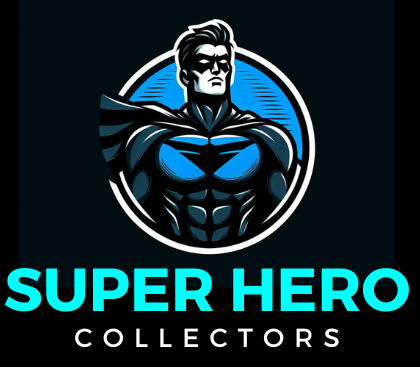
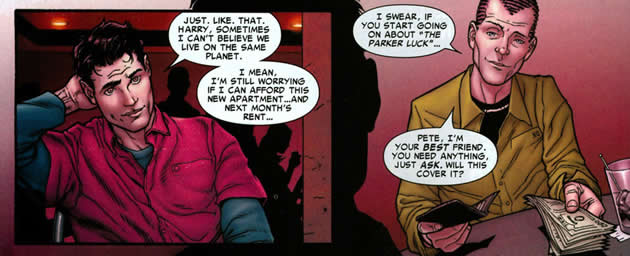
Wow, this post is eye-opening, especially for people like me, who are not so into these marvel characters or stories.
I have watched a Spider man movie only once or twice, I think and I didn’t realize until now, that these movies have background stories of the characters, especially Peter Parker and Harry Osborne and their lives, as you mentioned are depicting on their life choices.
Truly, how we face challenges, start with our decisions to be good and kind and helpful, like Peter Parker ( Spiderman ).
Everyone has a mission in life, and if we are sensitive to this, we will have a productive life, just like our super heroes.
Marita
Hi Marita,
Thank you so much for your thoughtful comment! I’m thrilled to hear that you found the post eye-opening, especially as someone who isn’t deeply into Marvel characters or stories. It’s fascinating how much depth and background the writers and creators put into these characters, isn’t it?
Indeed, Peter Parker and Harry Osborn have rich backstories that shape their actions and choices, making their dynamic complex and compelling. Peter’s journey, in particular, is a powerful reminder of the impact of our decisions and the importance of choosing kindness and responsibility, even when faced with adversity.
You’re absolutely right—everyone has a mission in life, and being mindful and sensitive to our purpose can lead to a fulfilling and productive life. Just like our superheroes, our challenges can be stepping stones to becoming better versions of ourselves.
Thanks again for your comment, Marita. It’s great to see how these stories resonate on different levels with people, whether they’re long-time fans or just getting introduced to the characters.
Best,
Scott
Scott, this is an excellent analysis of these two seminal Marvel characters. Archetypes are educational is so many ways as I know only too well as a literary author. They are a powerful way to teach people their shortcomings and their strengths, too.
my question: Would the lives of Parker and Osborne be as poignant to you and other Marvel fans if they were in text form only without the graphics? I believe that all human beings have to power to imagine through visual and auditory stimuli, so literary heroes take the form that each individual reader tends towards without the pictures comics provide. This leaves more freedom to create images of heroes for the reader.
I am working with AI artists these days so I can use my own words directly as prompts to generate images! What influence, if any, do you think AI will have on comics in the future?
Thank you for this stunning analysis and reference resource!
Hi Linden,
Welcome back! As always your comments and questions are insightful.
I think that the lives of Parker and Osborn, as well as their dynamics would resonate differently if conveyed solely through text. Marvel’s strength lies in its blend of compelling storytelling and striking visuals. The graphic element adds a layer of immediacy and emotional impact that text alone might struggle to achieve. However, the essence of their stories—their struggles, growth, and relationships—could still be deeply moving in text form. The vivid imagery provided by comics enhances the narrative but doesn’t define the depth of the characters themselves. In text, readers can employ their imagination to visualize scenes and emotions, potentially creating a more personalized and equally poignant experience. I have a vivid imagination when I read a novel. I have an idea in mind what the characters look like and even hear their voices in my head.
I think in the future, AI will be used to enhance the comics, but I don’t believe the human touch can be replaced. Human touch is important in storytelling and art. AI can assist artists by generating initial concepts or entire panels based on textual descriptions, streamlining the creative process and offering new artistic possibilities. This could lead to more diverse and innovative visual styles, as AI can draw from a vast array of influences and techniques. AI can become a likely tool for creators for enhancement, rather than replacement.
Thank you again for your kind words and engaging questions! Your work with AI artists sounds fascinating and could indeed be a glimpse into the future of visual storytelling.
– Scott
Great article! The deep dive into Peter Parker and Harry Osborn’s relationship is fascinating. Their friendship and rivalry add depth to their characters and the Marvel universe. One question: How would their relationship have evolved if Harry hadn’t taken on the Green Goblin mantle? Would they have remained close friends, or were their differences too significant to overcome without the added conflict?
I am looking forward to your thoughts!
Hi Vlad!
Thank you so much for your kind words! I’m thrilled to hear that you enjoyed the deep dive into Peter Parker and Harry Osborn’s relationship. It’s one of the most compelling dynamics in the Marvel universe, full of complexity and emotional depth.
Your question about how their relationship might have evolved if Harry hadn’t become the Green Goblin is intriguing. It’s always fun to ask “What if?” Even Marvel has a series called “What if..?
Without the Green Goblin mantle adding layers of conflict and tragedy, it’s likely that their friendship would have faced different, but still significant, challenges.
At the core, Peter and Harry’s differences stem from their vastly different upbringings and personal struggles. Peter, burdened with the responsibility of his powers and the loss of his uncle, often struggles with balancing his dual life. Harry, on the other hand, grapples with the immense pressure of living up to his father’s expectations and his own insecurities.
Without the Green Goblin’s influence, these underlying issues would still be present. Peter’s secret identity and the constant danger associated with being Spider-Man would continue to strain their friendship, especially if Harry remained unaware of Peter’s double life. Additionally, Harry’s need for approval and validation from his father, Norman Osborn, could lead to feelings of inadequacy and resentment towards Peter, who often excels in areas where Harry falters.
As I have been reading a lot of the early Spider-Man comics, I see Harry filled with paranoia, possibly from the drugs. Way before he became the Goblin, he was getting angry with Peter and even accused him of trying to steal his girl Mary Jane, even though it wasn’t true. It seemed like Harry was trying to push everyone away.
However, without the direct conflict of Harry becoming a villain, there’s a good chance their friendship could have had more opportunities for reconciliation and growth. They might have found common ground and supported each other through their personal battles. The absence of betrayal and the life-and-death stakes of their confrontations as hero and villain could allow them to navigate their differences with more empathy and understanding.
Ultimately, while their friendship would still be tested by their personal demons and the secrets Peter keeps, the absence of the Green Goblin might have allowed them to remain close, provided they could work through their issues together. It’s a fascinating “what if” scenario that highlights the depth and complexity of their characters.
Thank you again for your insightful question! I’m looking forward to exploring more of these dynamics in future posts.
– Scott
wow, I like this article you have put together on the dynamic relation between these two characters and how their interactions made for good story telling. However you didn’t just talk about them but also the way the other characters where influence or driven or even killed because of their struggle or interactions with each other.
while I don’t read comics anymore and I have no clue where the story is anymore, I would like for the two characters to find some sort of peace from their struggles, what do you think, have they found peace or will they ever in the future.??
well I’m off to read more of your articles as I enjoy this one so much thank you so much for putting this together as it was well written and entertaining to read.
HI Doug!
Thank you so much for your kind words! I’m thrilled to hear that you enjoyed the article and found it both well-written and entertaining. The dynamic between Peter Parker and Harry Osborn is indeed a rich and complex one, with far-reaching impacts on the other characters in their universe. Their struggles and interactions have undeniably shaped many pivotal moments in the Spider-Man series.
As for your question about whether Peter and Harry will ever find peace from their struggles, it’s a thought-provoking one. In the comics, their relationship has always been a rollercoaster of friendship, rivalry, and tragedy. There have been moments of reconciliation and understanding, but the nature of their world often brings new challenges and conflicts. In the Spectacular Spider-Man series, Harry as Green Goblin actually dies while saving Spider-Man. This is much in the same way the Toby Maguire Spider-Man movies showed Harry’s death.
In some storylines, we do see them finding temporary peace. For instance, there are arcs where Harry overcomes his demons and Peter forgives him, leading to a fragile but sincere truce. In the Spider-Man Worldwide story arc, Peter owns a worldwide corporation and has Harry in the top position of making decisions! However, the ever-evolving nature of comic book narratives means that their peace is often short-lived, disrupted by new threats and old grudges.
Looking to the future, it’s hard to say definitively if they will ever find lasting peace. The storytelling potential of their tumultuous relationship is significant, and writers often leverage this to explore deeper themes of friendship, redemption, and the impact of past choices.
Again, thank you for your thoughtful comment and for reading my articles. I’m glad you found this one engaging, and I hope you continue to enjoy more of my work. Feel free to share any other thoughts or questions you have—I love discussing these characters and their stories!
– Scott
Hi, just wanted to say I read your article and I liked the Spiderman article with Peter Parker and Harry Osborn. It was interesting. I grew up watching the original Spiderman with Peter Parker and enjoyed it a lot. That is too bad Peter Parker and Harry Osborn couldn’t stay friends and work out there problems. Each of them had personal struggles and could have worked it out to survive. I enjoy reading the article as I also grew up reading super hero comic books as a kid.
Hi Andrew!
Welcome to Super Hero Collectors! I am happy you enjoyed my post and analysis. Thank you for taking the time to read and leaving a comment.
I hope you come back often for more superhero fun!
– Scott
Hey Scott,
This article on the dynamics between Peter Parker and Harry Osborn is truly captivating and made me wonder, how would their friendship have evolved if Harry had never discovered Peter’s secret identity?
Additionally, in what ways do you believe Harry’s complex relationship with his father influenced his interactions with Peter?
Lastly, considering the various adaptations of their story, which version of their friendship do you find most compelling and why?
Thanks for delving into such a fascinating aspect of their characters.
Welcome back, Sara!
Thank you for your thoughtful comment! I’m glad you found the article on Peter Parker and Harry Osborn’s dynamics captivating.
To address your first question, if Harry had never discovered Peter’s secret identity, their friendship would likely have remained more stable for a longer period. The discovery of Peter’s identity as Spider-Man introduces a significant conflict, primarily due to Harry’s feelings of betrayal and the weight of his father’s legacy. Without this revelation, Harry would not have had the same motivation to turn against Peter, allowing their bond to develop more naturally, possibly even giving Peter a stronger ally in his fight against crime.
Harry’s complex relationship with his father, Norman Osborn, profoundly influences his interactions with Peter. Norman’s high expectations and manipulative tendencies create a constant pressure on Harry, leading him to seek validation and approval. This dynamic often leaves Harry feeling overshadowed and inadequate, contributing to his jealousy and insecurity. When Harry discovers that his best friend is also his father’s greatest enemy, it exacerbates these feelings, causing a deep rift. Harry’s need to prove himself to Norman often conflicts with his loyalty to Peter, adding layers of complexity to their relationship.
Regarding the various adaptations of their story, I find the version from the Sam Raimi Spider-Man trilogy particularly compelling. The portrayal of their friendship and subsequent rivalry is deeply emotional and nuanced. James Franco’s performance as Harry captures the internal struggle between his loyalty to Peter and his desire to avenge his father’s death. This adaptation effectively highlights the tragic elements of their relationship, making their eventual confrontation and reconciliation all the more impactful.
I hope you come back again for more superhero fun!
Best,
Scott
I enjoyed reading this information. I am a massive fan of the Spiderman movies, so it was good for me to learn more into their relationship.
I have never really gotten into the comics, but your info here is quite interesting and possibly, just possibly I may give them a try. There is often a lot of material to be enjoyed in written form that does not make it to the big screens. Is this the case here?
As an obvious fan yourself, do you think the movies have done justice to their friendship and rivalry compared to the comics?
Thanks and I enjoyed my visit.
Chris
Hi Chris,
Thank you for your thoughtful comment! I’m glad to hear that you enjoyed the post and that it sparked your interest in the comics. The relationship between Peter Parker and Harry Osborn is indeed one of the richest and most complex in the Spider-Man universe, and the comics delve into it with a depth that’s hard to fully capture on screen.
To answer your question, yes, there is a wealth of material in the comics that doesn’t make it to the movies. The comics explore their friendship and rivalry over many years and across numerous story arcs, providing a nuanced view of their evolving dynamic. For example, the impact of Harry’s father, Norman Osborn (the Green Goblin), on their relationship is explored in much greater detail in the comics. There are also storylines involving Harry’s own struggles with becoming the Green Goblin and his attempts to step out of his father’s shadow, which add layers to his character.
Regarding whether the movies have done justice to their friendship and rivalry, I think it’s a mixed bag. The Raimi trilogy with Tobey Maguire and James Franco does a good job of capturing the tragic elements of their friendship and eventual enmity, particularly in “Spider-Man 3.” However, due to time constraints, some of the subtleties and long-term developments from the comics are inevitably compressed or omitted.
In “The Amazing Spider-Man” series, the relationship is reintroduced but with less time to develop it fully. The dynamic is still there, but it doesn’t have the same emotional weight as in the comics or the Raimi films.
The Marvel Cinematic Universe (MCU) hasn’t focused much on Harry Osborn yet, so it remains to be seen how they might handle this aspect of Spider-Man’s story if they choose to explore it in future films.
A good place to start reading Spider-Man comics is at the beginning. You can find collections of comic book issues that are really fun to read. Marvel Masterworks: Amazing Spider-Man Vol 1.
Thanks again for stopping by and sharing your thoughts. I hope you enjoy your journey into the world of Spider-Man comics!
I hope you keep visiting for more superhero fun!
– Scott
Dear Scott,
This is an unexpectedly fascinating text for me. Apart from being informative and educational, it opens up many topics for questioning ourselves and our relationships.
Apart from the above, I have to express great admiration for your maturity. Namely, it is phenomenal how clearly you are defined in the whole text regarding morals and correct values without even once falling into the trap of condemning Osborne. It is truly a sign of deep maturity and fantastic writing skills.
I enjoyed it, thank you!
Welcome back and thank you for your kind words. I really enjoy digging deep into these stories and characters, and I am so happy that you enjoyed it as well!
I hope you come back again!
– Scott
Hi Scott
The article on the dynamics of Peter Parker and Harry Osborn offers a compelling analysis of their complex relationship. It delves into the intricacies of their friendship and how it evolves with Harry’s transformation into the Green Goblin, highlighting the emotional and psychological turmoil that Peter faces.
The piece effectively captures the essence of their bond, showing how their past camaraderie clashes with their present adversarial roles. It’s a nuanced look at how personal connections can shape, and sometimes complicate, the lives of superheroes.
What are your thoughts on how their friendship impacts Spider-Man’s decisions and actions throughout the series?
Hi Troy!
Welcome back and thank you for your thoughtful comment on my article about the dynamics between Peter Parker and Harry Osborn. I’m glad to hear that you found the analysis compelling and nuanced. Their relationship indeed adds a rich layer of complexity to Spider-Man’s story, making it more than just a tale of heroism and villainy.
Regarding your question, Harry and Peter’s friendship significantly impacts Spider-Man’s decisions and actions throughout the series. Here are a few key points:
Moral Dilemmas: Peter often finds himself torn between his duty as Spider-Man and his loyalty to Harry. This internal conflict is especially evident when Harry becomes the Green Goblin. Peter’s hesitation to fight Harry, despite the latter’s dangerous actions, showcases his deep sense of loyalty and the pain of possibly harming a friend.Guilt and Responsibility: Peter’s sense of responsibility is a core part of his character, famously encapsulated in Uncle Ben’s words, “With great power comes great responsibility.” Harry’s descent into villainy partly stems from his father’s legacy, and Peter feels a sense of guilt and responsibility for not being able to save Harry from this fate. This guilt often drives Peter to try and redeem Harry, sometimes at great personal cost.Influence on Personal Growth: The dynamics between Peter and Harry also influence Peter’s growth as a person and as Spider-Man. Their friendship, rivalry, and the resulting conflicts force Peter to confront his values, his limits, and his approach to justice and redemption. These experiences shape his identity and resilience.Impact on Relationships: Harry and Peter’s tumultuous relationship also affects Peter’s other relationships. For instance, it creates tension in his relationship with Mary Jane, who is caught between her feelings for both men. The strain of balancing his life as Peter Parker and Spider-Man is exacerbated by the complications arising from his friendship with Harry.
In essence, Harry’s presence in Peter’s life adds depth to the narrative, making Spider-Man’s journey more relatable and emotionally charged. The interplay of friendship and enmity between them reflects the complex nature of human relationships, even within the superhero genre.
Thanks again for your insightful comment. Feel free to share more thoughts or questions!
Keep coming back for more superhero fun!
– Scott
Hi Scott,
Thank you for this fun-filled and entertaining article exploring the dynamic intertwined lives of Peter Parker (Spider-Man) and Harry Osborn (Green Goblin). Your article covers their backgrounds, character development, relationships, morals, compasses, and impact on the Marvel Universe.
The article effectively highlights how their contrasting backgrounds and moral struggles shape their journeys.
This in-depth analysis of their complexity and relationship not only deepens our understanding of these two iconic characters but also emphasizes the importance of the timeless appeal and relevance of their stories in popular culture.
One can only conclude that the relationship between Peter and Harry showcases the power of character-driven story-telling, moral struggle, responsibility, and the impact of upbringing.
I appreciate your sharing of this timeless piece.
Thanks.
Makinde
Hi Makinde,
Welcome back! Thank you for your thoughtful and encouraging comment! I’m glad to hear that you enjoyed the article and found the exploration of Peter Parker and Harry Osborn’s dynamic both entertaining and insightful.
It’s fascinating how their contrasting backgrounds and moral dilemmas create such a rich narrative, and I’m pleased that the article conveyed their complexities and the depth of their relationship. The enduring relevance of their stories indeed underscores the power of character-driven storytelling and the profound impact of their moral struggles and upbringing.
Your kind words reaffirm the timeless appeal of these characters and their stories within the Marvel Universe. It’s always a pleasure to share insights on such iconic figures, and I’m grateful for readers like you who appreciate the nuances of their journeys.
Thank you for taking the time to read and share your thoughts, and I hope you continue to visit for more superhero fun!
Best,
Scott
This article is fantastic! Everybody knows who Peter Parker is—he’s Spider-Man! But how many know much at all about Harry Osborn? Very few, I’ll bet. You talk about these guys like you know them intimately, and your understanding of their psyches is clinical. Are you a psychiatrist?
I’ve seen a few of the Spiderman movies. I think Willem Defoe played Norman. He is a memorable actor who has played everything from Osborn to Van Gogh.
Thank you for this superb article. I look forward to reading more.
Hi Dave!
Thank you for your kind words! I’m thrilled that you enjoyed my post. I’m not a psychiatrist, just a guy that enjoys writing about Marvel.
Willem Dafoe was great! When I read Spidey comics with the Goblin, I still imagine his voice in my head.
I hope you come back for more superhero content! I have several posts about Spider-Man.
– Scott
Wow, what an incredible deep dive into the complex relationship between Peter Parker and Harry Osborn! Peter Parker’s evolution from a shy, science-loving teenager to the iconic Spider-Man is always inspiring. His unwavering commitment to Uncle Ben’s principle “With great power comes great responsibility” continues to resonate deeply. It’s fascinating to see how Peter’s struggles and growth reflect the very essence of heroism, balancing personal sacrifice with the greater good.
On the other hand, Harry Osborn’s journey is equally compelling, though often tragic. His battle with addiction, his complicated relationship with his father, and his eventual transformation into the Green Goblin highlight the darker side of human nature. The contrast between Harry’s internal conflict and Peter’s steadfast morality adds so much depth to their story.
Thank you for this thorough and insightful analysis. It truly enriches our understanding of these iconic characters. Looking forward to more deep dives into the Marvel Universe!
Hi Kavitha!
Thank you so much for your thoughtful comment! I’m thrilled to hear that you enjoyed the deep dive into Peter Parker and Harry Osborn’s relationship.
Peter Parker’s journey from a shy, science-loving teenager to the iconic Spider-Man is indeed inspiring. His adherence to Uncle Ben’s principle, “With great power comes great responsibility,” is a cornerstone of his character and a powerful reminder of the balance between personal sacrifice and the greater good. It’s fascinating to see how Peter’s struggles and growth embody the essence of heroism.
Harry Osborn’s story is compelling in its own right. His battle with addiction, complex relationship with his father, and transformation into the Green Goblin showcase the darker aspects of human nature. The contrast between Harry’s internal conflict and Peter’s steadfast morality adds incredible depth to their narrative, making their dynamic one of the most engaging in the Marvel Universe.
I’m glad you found the analysis enriching, and I appreciate your enthusiasm for more deep dives into the Marvel Universe. Stay tuned for more explorations of these iconic characters and their intricate stories!
– Scott
This article was a great read! The dynamic between Peter Parker and Harry Osborn has always been one of the most compelling aspects of the Spider-Man story. It’s fascinating to see how their friendship and rivalry shape their characters and the overall narrative.
As a mom with a young son who absolutely adores Spider-Man, I’m always on the lookout for interesting content about Peter Parker to share with him. This deep dive into his relationship with Harry Osborn offers a lot of insights that I think he’d find intriguing, especially how their bond evolves over time.
Have you explored other significant relationships in Spider-Man’s life that are just as impactful? I think my son would love to learn more about them too!
HI Cassie!
Thank you for you comments and I’m thrilled you enjoyed this post.
I have written more about Spider-Man than any other Marvel character, and I don’t think I’m finished yet! I have a post about his relationship with Mary Jane Watson, the Green Goblin, and even his many loves!
Check out the menu at the top of the page and click on Heroes. You will see a sub-heading for Spider-Man. Don’t forget the post about his relationships at the Daily Bugle too!
I hope your son enjoys these and that you will come back for more superhero content!
– Scott